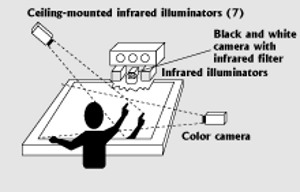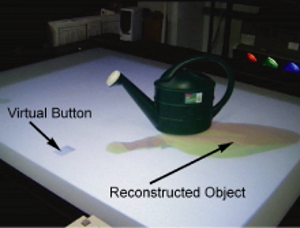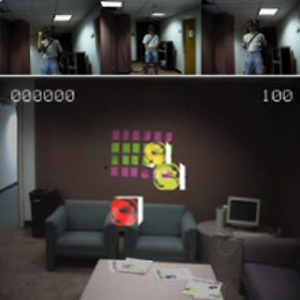Publications
Toward Spontaneous Interaction with the Perceptive Workbench

Until now, we have interacted with computers mostly by using wire-based devices. Typically, the wires limit the distance of movement and inhibit freedom of orientation. In addition, most interactions are indirect. The user moves a device as an analog for the action created in the display space. We envision an untethered interface that accepts gestures directly and can accept any objects we choose as interactors. We discuss methods for producing more seamless interaction between the physical and virtual environments through the Perceptive Workbench. We applied the system to an augmented reality game and a terrain navigating system. The Perceptive Workbench can reconstruct 3D virtual representations of previously unseen real-world objects placed on its surface. In addition, the Perceptive Workbench identifies and tracks such objects as they are manipulated on the desk's surface and allows the user to interact with the augmented environment through 2D and 3D gestures
@article{leibe2000toward,
title={{Toward Spontaneous Interaction with the Perceptive Workbench}},
author={{Leibe, Bastian and Starner, Thad and Ribarsky, William and Wartell, Zachary and Krum, David and Weeks, Justin and Singletary, Bradley and Hedges, L},
journal={{Computer Graphics and Applications, IEEE}},
volume={20},
number={6},
pages={54--65},
year={2000},
publisher={IEEE}
}
The Perceptive Workbench: Toward Spontaneous Interaction in Semi-Immersive Virtual Environments

The Perceptive Workbench enables a spontaneous, natural, and unimpeded interface between the physical and virtual worlds. It uses vision-based methods for interaction that eliminate the need for wired input devices and wired tracking. Objects are recognized and tracked when placed on the display surface. Through the use of multiple light sources, the objectÕs 3D shape can be captured and inserted into the virtual interface. This ability permits spontaneity since either preloaded objects or those objects selected on the spot by the user can become physical icons. Integrated into the same vision-based interface is the ability to identify 3D hand position, pointing direction, and sweeping arm gestures. Such gestures can enhance selection, manipulation, and navigation tasks. In this paper, the Perceptive Workbench is used for augmented reality gaming and terrain navigation applications, which demonstrate the utility and capability of the interface.
@inproceedings{leibe2000perceptive,
title={{The Perceptive Workbench: Toward Spontaneous Interaction in Semi-Immersive Virtual Environments}},
author={{Leibe, Bastian and Starner, Thad and Ribarsky, William and Wartell, Zachary and Krum, David and Singletary, Brad and Hodges, Larry}},
booktitle={{Natural Interaction in Semi Immersive Virtual Environments, in Proceedings of IEEE Virtual Reality 2000}},
year={2000},
organization={Citeseer}
}
MIND-WARPING: Towards Creating a Compelling Collaborative Augmented Reality Game

Computer gaming offers a unique test-bed and market for advanced concepts in computer science, such as Human Computer Interaction (HCI), computer-supported collaborative work (CSCW), intelligent agents, graphics, and sensing technology. In addition, computer gaming is especially wellsuited for explorations in the relatively young fields of wearable computing and augmented reality (AR). This paper presents a developing multi-player augmented reality game, patterned as a cross between a martial arts fighting game and an agent controller, as implemented using the Wearable Augmented Reality for Personal, Intelligent, and Networked Gaming (WARPING) system. Through interactions based on gesture, voice, and head movement input and audio and graphical output, the WARPING system demonstrates how computer vision techniques can be exploited for advanced, intelligent interfaces.
@inproceedings{starner2000mind,
title={{MIND-WARPING: towards creating a compelling collaborative augmented reality game}},
author={{Starner, Thad and Leibe, Bastian and Singletary, Brad and Pair, Jarrell}},
booktitle={{Proceedings of the 5th international conference on Intelligent user interfaces}},
pages={256--259},
year={2000},
organization={ACM}
}
Previous Year (1999)

